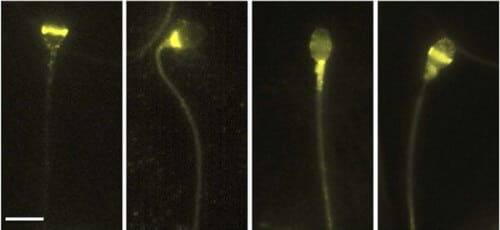
In their challenging way to the desired egg, the sperm cells use sensors that until now were mainly known as part of the vision system. This surprising finding emerges from a new study by scientists at the Weizmann Institute of Science Recently published in the scientific journal Scientific Reports.
From the moment a human sperm cell enters the fallopian tube, it must travel several centimeters to reach the egg - a distance equivalent to a journey of several kilometers for a person. In this way, and in order to reach the goal and carry out fertilization, the sperm cell must navigate according to road signs without which it cannot overcome various obstacles.
In previous studies, he discovered Prof. Michael Eisenbach and members of his group from the Department of Biological Chemistry at the Weizmann Institute of Science, two types of such landmarks: chemical and thermal. Heat works at relatively large distances: the fertilization site is warmer than the place where the sperm cells stop and mature at the entrance to the fallopian tube, and the temperature difference leads them towards the egg. When they approach the fertilization site, they pick up the chemical signals that the egg secretes. Prof. Eisenbach: "As happens in many important processes in nature, the sperm cells rely on more than one mechanism during the navigation to the egg, so that if one means of navigation fails, the others can be a backup and lead the sperm cell to its destination."
Sperm cells are very sensitive to temperature differences: on a section of road the length of one sperm cell (about 50 thousandths of a millimeter) they are able to sense a temperature difference of only 0.0006 degrees.
In the new study, Prof. Eisenbach and his group members examined how the sperm cells sense the temperature differences. The group included Dr. Serafin Perez-Serzels, Dr. Sergey Borishpolts, research student Oshri Afanzar, Dr. Rinat Nebo Vladimir Kish from the Department of Biological Chemistry and Dr. Alexander Brandis from the Biological Services Unit. The scientists focused on a group of protein receptors, GPCRs, which based on their previous studies seemed to be candidates to be involved in transmitting signals to the sperm cell. After finding that this large group is indeed involved in heat sensing, they discovered that the receptors responsible for this - within the group - are proteins called opsins (opins).
Opsins are best known for their role in a completely different area: the visual system. One protein from the group, called rhodopsin, is particularly known as the main pigment used as the light receptor in the retinal cells of the eye, but in the fruit fly larva it is involved in the response to heat.
In the new study, members of Prof. Eisenbach's research group found that several proteins in the opsin family are found on the surface of sperm cells in mice and humans. Each of these vision proteins is located in a different location, and each probably contributes to helping the seed sense heat through a separate signaling pathway. When the scientists blocked the signals sent by opsins, the sperm cells were unable to navigate from a cooler area to a warmer area.
These surprising findings may explain the presence of opsins in body organs that are not exposed to light, such as the lungs and liver. The scientists say that opsins may also be used as heat sensors in these organs.

One response
"These surprising findings may explain the presence of opsins in body organs that are not exposed to light, such as the lungs and liver. The scientists say that opsins may also be used as heat sensors in these organs." - Why? Why do we need these sensor proteins in our body, in our organs? Are the liver and lungs supposed to feel their heat? not clear to me.